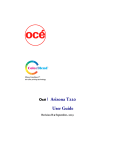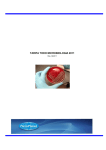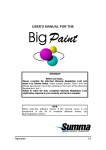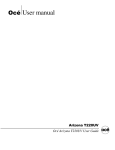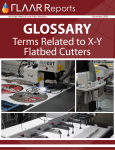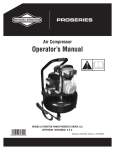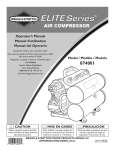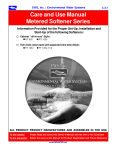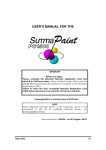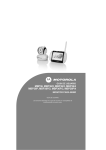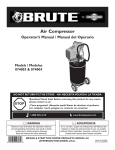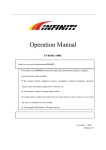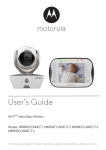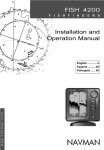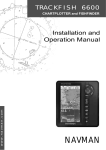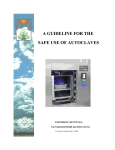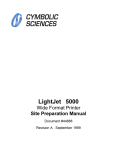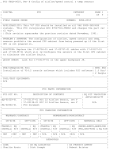Download Océ T220 Industrial Application Ink
Transcript
Océ T220 Industrial Application Ink Product Information Manual Using the Océ Arizona T220 solvent ink printer in the vacuum formed sign manufacturing process Issued by: Jeff Edwards Approved by: Status: Released Document Océ Part #3010103885 Revision: A Date: February 22, 2005 STRICTLY CONFIDENTIAL Océ T220 Industrial Application Ink Product Information Manual Table of Contents 1 CONTACT LIST 4 2 EXECUTIVE SUMMARY 5 3 THE PRODUCT – TECHNOLOGY, FEATURES AND BENEFITS 6 4 THE MARKET – SIZE AND SEGMENTATION 12 5 PRICING AND ORDERING 13 6 MARKET POSITIONING 15 7 COMPETITION 16 8 PROMOTION 18 9 SERVICE AND SUPPORT 19 APPENDIX A: COST COMPARISON 23 APPENDIX B: MSDS INK DOCUMENTS 25 APPENDIX C: MASTER PARTS LIST 26 APPENDIX D: PRESS RELEASE 27 APPENDIX E: OCÉ T220 INDUSTRIAL APPLICATION INK ADVANCED APPLICATIONS TRAINING OVERVIEW 30 APPENDIX F: ORDER FORM 31 APPENDIX G: CORE MATERIAL LIST 32 APPENDIX H: APPLICATION GUIDE 33 Page 2 of 52 STRICTLY CONFIDENTIAL Océ T220 Industrial Application Ink Product Information Manual APPENDIX I: CONVERSION INSTRUCTIONS 39 APPENDIX J: SERVICE TRAINING OUTLINE 46 APPENDIX K: CUSTOMER PROFILE FORM 47 APPENDIX L: OCÉ T220 INDUSTRIAL APPLICATION INK BROCHURE 49 APPENDIX M: OCÉ T220 INDUSTRIAL APPLICATION INK SITE PREPARATION MANUAL 52 Page 3 of 52 STRICTLY CONFIDENTIAL Océ T220 Industrial Application Ink 1 Product Information Manual Contact List For questions, feedback or additional information regarding the Océ T220 Industrial Application Ink for use in the Océ Arizona T220 flatbed solvent inkjet printer, please contact the relevant individuals listed below. 1.1 Marketing Product Management Product Marketing Manager Jeff Edwards + 1 604 232 2288 [email protected] 1.2 Service and Support Service Product Manager 1.3 Mike Gibson +1 604 232 2261 [email protected] Marketing Communications Director of Communications Kelli Ramirez +1 530-346-2146 [email protected] 1.4 User Documentation Technical Documentation Specialist 1.5 Richard Barazzol +1 604 232 2327 [email protected] Consumables Jeff Edwards + 1 604 232 2288 [email protected] 1.6 Other – not applicable Page 4 of 52 STRICTLY CONFIDENTIAL Océ T220 Industrial Application Ink 2 Product Information Manual Executive Summary 2.1 Introduction The Océ Arizona T220 solvent printer has been used to print on many materials since it’s introduction in 2003. Customers have been successfully producing work for sale on vinyl, glass, fome-cor, styrene, Sintra, Di-Bond, Forex, plywood and melamine. With few exceptions, the work produced by the Arizona T220 has been the final, saleable product. Graphic applications have included flat or banner signage, Point-of-Purchase materials, Point-of-Sale collateral, exhibition display and other display graphics applications. The use of the Océ Arizona T220 in the formed sign manufacturing process is somewhat different. This application represents the first use of this printer as an intermediate tool in a valueadded manufacturing process and is of tremendous value as a result. Instead of comparing production speed and cost input per square meter against competitive systems, this application can be sold on the basis of a manufacturing cost reduction against the traditional vacuum-formed sign manufacturing process. The benefits to the customer are tremendous in every respect over traditional methods. 2.2 Why This Product? Using the Océ Arizona T220 solvent printer to directly print on the media prior to forming can reduce the cost of manufacturing a typical multi-coloured, formed sign by as much as 80%. This is achieved through either eliminating the labour and materials required to screenprint the sign before forming, or to color the sign after forming. Additionally, it can dramatically increase the quality level that can be achieved by any other method. This PIM describes the method by which the Océ Arizona T220 can be used in the formed sign manufacturing process and the subsequent benefits to the sign manufacturer and their customers. It also outlines the service and support tools necessary to support customers that are using the printer in this configuration. Page 5 of 52 STRICTLY CONFIDENTIAL Océ T220 Industrial Application Ink 3 Product Information Manual The Product – Technology, Features and Benefits The Océ T220 Industrial Application Ink now available for use in the Océ Arizona T220 flatbed solvent inkjet printer is specifically designed to have properties favourable for the manufacture of vacuum-formed signs or decorative articles. Three-dimensional outdoor identity signs may be printed on transparent or translucent materials and backlit, depending on need. The Océ T220 Industrial Application Ink is a special formulation that provides the pigment loading and surface properties required to maintain colour density as the plastic substrate stretches over the mould. This is a significant benefit over other solvent inks that do not provide sufficient density to allow the material to stretch and over UV-curable inks that actually crack and peel during the forming process. The economics of the traditional method of sign creation are such that the high ink usage and other maintenance costs associated with this new ink are not considered prohibitive – a situation that would not be generally acceptable for general graphic arts applications. 3.1 Technology Point 1 The ink has been designed with the following general properties: High Pigment Load The ink has an unusually high pigment load, allowing for extraordinary color density in the printed image. This is a distinct advantage for this application in that it allows the ink to impregnate the media and then stretch as the media is thermo-formed without a significant colour density loss. Other solvent inks are only capable of achieving similar density levels with several in-register over-prints. Low Surface Tension The ink has very low surface tension allowing for rapid jetting in the printer and significant stretch in the formed image, without cracking in the printed image. Fast Drying The ink is a very fast drying formulation. While this property does make it a little more challenging to work with, it also allows the use of lower temperatures in the drying process on the printer thus causing less “local” media distortion and allowing for faster absorption into the printed media. These are general properties of the ink only and are delivered in an intentionally vague manner due to the proprietary nature of this information. Safety details of the inks and associated chemical solutions can be found in Appendix B, by reviewing the appropriate MSDS sheets. These sheets are available in the standard eight languages. Page 6 of 52 STRICTLY CONFIDENTIAL Océ T220 Industrial Application Ink 3.2 Product Information Manual Technology Point 2 The manufacturing technique can only be successfully achieved with true flatbed technology for a variety of reasons. Media Mass Media suitable for use in the vacuum-formed manufacturing process tends to be very heavy and is difficult and often impossible to move in a friction-feed system such as those used on competitive systems. The Océ Arizona T220 is a true flatbed printer and as a result, the media is held stationary on the printer during imaging. Mass and thickness are not limiting factors in any practical way. Necessity for Over-Printing Some signs require unusual color densities for transparent/translucent applications. Often these very high densities can only be achieved by over-printing the image on the media two (or more) times prior to forming. This is virtually impossible to attempt using an imaging architecture in which the media moved through the printing zone, but the Océ Arizona T220 with its incredible flatbed registration and repeatability, excels at it. 3.3 Product Specifications NEW Océ T220 Industrial Application Inks An entirely new ink set and flushing solution has been released to support this new application. A new capping solution will be made available shortly. Please note that this ink does NOT replace the original Océ Arizona T220 inks, the T2200 Series inks manufactured for Océ by 3M. These inks are meant for use in this specific application only. Océ Part # Minimum Order Qty Bottle Volume Océ T220 Industrial Application Ink Cyan 3010103481 1 bottle 1 litre Océ T220 Industrial Application Ink Magenta 3010103482 1 bottle 1 litre Océ T220 Industrial Application Ink Yellow 3010103483 1 bottle 1 litre Océ T220 Industrial Application Ink Black 3010103484 1 bottle 1 litre Océ T220 Industrial Application Ink Light Cyan 3010103485 1 bottle 1 litre Océ T220 Industrial Application Ink Light Magenta 3010103486 1 bottle 1 litre Océ T220 Industrial Application Ink Flushing Fluid 3010103506 1 bottle 3 litres Item Description Page 7 of 52 STRICTLY CONFIDENTIAL Océ T220 Industrial Application Ink Product Information Manual NEW Starter Kit w/ Océ T220 Industrial Application Inks A new starter kit is being made available for any Arizona T220 systems intended for use in vacuum-formed sign manufacturing. The new starter kit is identical to the original T220 starter kit with the exception of the new inks and flushing solution. Also included is a full set of ink connection adapters to change the fittings on the standard Océ Arizona T220 to fit the new ink bottles/fittings. Item Description Starter Kit - T220 Industrial Application Inks Océ Part # Minimum Order Qty Bottle Volume 3010103479 1 kit N/A Recommended Capping Solution IMPORTANT: At this time, a capping solution is not yet available for this specific ink set from the manufacturer. Based on testing and field trials we recommend that the standard Arizona T220 solvent (Océ part number 3011690057) be used as a temporary capping solution until a new solution is released. This temporary replacement substance has been included in the new Starter Kit with the new Océ T220 Industrial Application Inks. Item Description 3M Scotchcal CGS-80 Solvent 3.4 Océ Part # Minimum Order Qty Bottle Volume 3011690057 1 bottle 3.78 litres Product Features & Benefits There are several benefits of this manufacturing technique over traditional techniques of three-dimensional sign manufacturing. They include: Reduced Costs Colored three-dimensional signs have been traditionally produced using one of two methods: signs are either colorized after forming by applying pre-pigmented cut vinyl or paint or before forming by screen printing the flat (unformed) panels. Both methods require extensive time and materials, although for different reasons, and have high wastage rates. The ability to directly print on the substance to be formed, results in tremendous cost-savings to the manufacturer, often as high as 80% in a small production run of signs. A more detailed examination of the cost comparisons between manufacturing methods is included in Appendix A. Page 8 of 52 STRICTLY CONFIDENTIAL Océ T220 Industrial Application Ink Product Information Manual Reduced Time to Manufacture Both traditional methods of three-dimensional sign manufacturing require a great deal of time to produce the first sign. In the case of signs colored after forming, the process of using cut vinyl or paint to apply color is very labour intensive and requires many iterative steps. When using paint, it is often necessary to wait for colors to dry before applying subsequent colors! Although the blank formed substrate is shaped very quickly, it requires several hours of labour, by a skilled craftsperson to produce the first sign. Subsequent signs are just as slow to complete using this technique. In the case of signs that are colored prior to forming using screen-printing, the time required to complete the extensive setup (see Competition below) means the first completed sign cannot be produced for several hours. This method does allow subsequent signs to be produced very quickly however and so it is well suited for larger production runs of fifty (50) or more identical signs. Improved Sign Quality A very significant benefit of directly writing the image onto the material to-be-formed is the resulting increase in image quality. This is particularly true of signs that contain halftone images or other photo-realistic data. Using traditional methods, these images can only be incorporated into a sign using a screen press to color the material. Screen presses use silk (or synthetic) fabric meshes to transfer the image to the material at a fixed screen “frequency”. The screen frequency that can be achieved using silk screening is actually very low, allowing for only coarse looking halftone images. When writing directly to the material, instead of transferring the image using a silk screen, much higher image quality is immediately achievable. A less than perfect analogy might be comparing the differences between photos printed in a daily newspaper to those found in a high quality magazine. Both are full color but the images printed on newsprint can only be printed at screen frequencies about half possible on fine gloss papers. Although the analogy is not perfect, it helps to illustrate the dramatic increase in quality that this application represents to a sign maker. 3.5 Media Like all solvent inks, these inks will print on a variety of media. The most common media used for this application are: PETG Acrylic ABS Foamed PVC Page 9 of 52 STRICTLY CONFIDENTIAL Océ T220 Industrial Application Ink 3.6 Product Information Manual Supported Software See Océ Arizona T220 Flatbed Solvent Printer PIM 3.7 Other Benefits Not applicable. 3.8 Included with the Product (Ship Kit) Not applicable. 3.9 Recommended Start Up Supplies (Starter Kit) The Starter Kit is mandatory when ordering a new system. It contains everything necessary to fill the system with ink and perform regular customer maintenance. Starter Kit Océ T220 Industrial Application Inks Océ Part # 3010103479 3.10 Accessories and Additional Options An upgrade kit will become available shortly after launch to allow existing Océ Arizona T220 customers who wish to use their current printer for this application. 3.11 Warranty, Service and Equipment Training Options See Océ Arizona T220 Flatbed Solvent Printer PIM Page 10 of 52 STRICTLY CONFIDENTIAL Océ T220 Industrial Application Ink 3.12 Product Information Manual Training Advanced Application Training is mandatory for this product and is available on request from Sign-Tronic, our partner in this initiative. The training is intended to be delivered to customers immediately after the system is installed and running. It consists of a four-day course and requires that the customer demonstrate proficiency in the application at the conclusion of the course. Included in the training fee is limited, remote support directly for the customer by email and telephone, for a period of one year. Please see the price schedule below and the listing of countries by region to determine what price you must charge for the advanced application training. Note: This is in addition to any standard system training you already offer your Arizona T220 customers. The Advanced Application training will cover issues specific to the creation of three-dimensional decorative signs and articles. See Appendix F for an outline of the issues covered in the four-day training course. At present, Advanced Application Training is only available in English. Translation services, if required, must be arranged and funded by the Operating Company. Please see Section 5.2 for ordering details. Duration Maximum Participants Price Advanced Application Training – Region 1 4 days 3 €14 500 Advanced Application Training – Region 2 4 days 3 US$17500 Advanced Application Training – Region 3 4 days 3 US$22500 Item Description Region 1 includes customers located in: Europe Middle East Region 2 includes customers located in: Canada USA Region 3 includes customers located in: Rest of World Page 11 of 52 STRICTLY CONFIDENTIAL Océ T220 Industrial Application Ink Product Information Manual 4 The Market – Size and Segmentation 4.1 Market Definition The market is defined as existing three-dimensional sign manufacturers, already utilizing conventional vacuum forming technology in their operation. It is very important that we not attempt to market this new manufacturing process to companies uninvolved with transparent/translucent sign production and/or vacuum forming. Companies not already engaged in these activities will not see the enormous benefits and will require a more extensive support in areas outside our areas of expertise. ODGS will only support the introduction of this product to existing vacuum forming sign manufacturers. 4.2 Applications Primary: Manufacturers of three-dimensional vacuum-forming signs. Secondary: Manufacturers of backlit or front lit, transparent or translucent signs. 4.3 Competition There are no competitive products on the market at this time. The only significant competition to this application are the conventional manufacturing techniques currently in use. They are described in chapter 7. Page 12 of 52 STRICTLY CONFIDENTIAL Océ T220 Industrial Application Ink 5 Product Information Manual Pricing and Ordering 5.1 Pricing The recommended List Price for the Océ T220 Industrial Application Ink is priced at a slight premium over the 3M ink for this printer. Please refer to OPRS for current ICP. 5.1.1 Equipment Printer pricing See Océ Arizona T220 Flatbed Solvent Printer PIM System pricing See Océ Arizona T220 Flatbed Solvent Printer PIM Service pricing See Océ Arizona T220 Flatbed Solvent Printer PIM Installation See Océ Arizona T220 Flatbed Solvent Printer PIM Starter Kit See OPRS Océ Part # 3010103479 Options Not applicable 5.1.2 Software - See Océ Arizona T220 Flatbed Solvent Printer PIM Onyx RipCenter Basic RIP; no pre-flight capability; includes driver See Océ Arizona T220 Flatbed Solvent Printer PIM Onyx PosterShop Recommended RIP; includes one driver See Océ Arizona T220 Flatbed Solvent Printer PIM Onyx ProductionHouse Includes two RIPs and supports four printers, one driver See Océ Arizona T220 Flatbed Solvent Printer PIM 5.1.3 Consumables – See Océ Arizona T220 Flatbed Solvent Printer PIM Page 13 of 52 STRICTLY CONFIDENTIAL Océ T220 Industrial Application Ink 5.2 Product Information Manual Ordering Consumables Inks and other consumables are available from Imaging Supplies using normal ordering procedures. Systems The Océ Arizona T220 Solvent printer is available through the regular Océ channels. All newly manufactured Océ Arizona T220 solvent systems will ship in a configuration suitable for this application. There is no custom system required, simply order the standard Océ Arizona T220 solvent system and the required Océ T220 Industrial Application Ink Starter Kit, Océ part # 3010103479. Training Advanced Application Training is mandatory for this product and is available on request from Sign-Tronic, our partner in this initiative. It must be ordered with the Arizona T220 system sale. ODGS will not provide a printer for this application unless the Operating Company confirms that training has been arranged with Sign-Tronic. The only exception is a customer ordering more than one Arizona T220 system for this application. In that case, the customer is only required to purchase and undergo the Advanced Application Training with the first system ordered. To place an order for training, please contact Sign-Tronic directly at: Sign-Tronic (Pty) Ltd. 2 Wessex Street Paarden Island 7420 Cape Town South Africa Contact: Adrian Wolman, Director Telephone: +27 21 510 8332 Fax: +27 21 434 5951 E-mail: [email protected] or [email protected] Please see section 3.12 for full details on Training. Page 14 of 52 STRICTLY CONFIDENTIAL Océ T220 Industrial Application Ink 6 Product Information Manual Market Positioning Positioning Statement The use of the Océ Arizona T220 solvent printer inked with Océ T220 Industrial Application Ink represents the first use of this printer as an intermediate tool in a valueadded manufacturing process. This application should be sold on the basis of a manufacturing cost reduction against the traditional vacuum-formed sign manufacturing process. The benefits to the customer are tremendous in every respect over traditional methods. 6.1 Target Markets The target market is defined as existing three-dimensional sign manufacturers, already utilizing conventional vacuum forming technology in their operation. It is very important that we not attempt to market this new manufacturing process to companies uninvolved with transparent/translucent sign production and/or vacuum forming. Companies not already engaged in these activities will not see the enormous benefits and will require a more extensive support in areas outside our areas of expertise. ODGS will only support the introduction of this product to existing vacuum forming sign manufacturers. Page 15 of 52 STRICTLY CONFIDENTIAL Océ T220 Industrial Application Ink 7 Product Information Manual Competition Traditionally, vacuum-formed sign makers have used several methods of manufacturing three-dimensional multi-colored signs. The chosen method is driven by run size. Larger runs of more than 50 signs are often screen printed prior to forming, while smaller runs are often painted or colored with pre-pigmented cut vinyl after forming, assuming of course that they have no photographic content. Method 1 – Screen printing the substrate before forming This method requires that the manufacturer create custom silk screens for each final colour that will appear on the sign. The characteristics of this method are: • Expensive make-ready process requiring up to 2-4 sets of silk screens, one for each color. • Trial and error approach to creating the image distortion needed to match the screened image with the form. • Very expensive in terms of time and materials to create the first acceptable sign. Long turn-around times for short runs. • Excellent economy for longer sign runs, exceeding 50 pieces. These signs can be 4-color process (CMYK), or spot color, or even a combination of both. They can also contain photographic images. Obviously, the more colors in a sign, the more screens required for the printing process, as each color requires a unique screen and a corresponding pass on the screen press. Color is applied to the flat (unformed) substrate one-by-one, through the screen press - which is a costly process in terms of the cost of the screens and press time. After printing, the sign must be formed. It is at this point that the integrity of the mould is first proved. Forming the sign distorts the image printed on the flat substrate and causes the image to bend irregularly around the mould. This almost always produces undesirable image distortion in the formed sign that appears as a registration error between the color and the intended position of the color in the sign. This registration error must be compensated for during imaging by distorting the image to account for the effects of the physical distortion in the final sign. After a vacuum (or pressure) former is used to mould the first sign, adjustments are made to the source image and new screens are created (one for each color), and the process begins again. The process is repeated until the final formed sign appears to be in acceptable register between the image and the mould. This usually takes three or four attempts and a tremendous amount of time, effort, and material expense, and opportunity time on the screen press. It is this expensive setup process that makes the traditional approach very expensive for short runs. In fact, this is one of the chief benefits of direct imaging on the Océ Arizona T220 over screen-printing for all graphic arts applications. Page 16 of 52 STRICTLY CONFIDENTIAL Océ T220 Industrial Application Ink Product Information Manual Advantages of Method 1: • Once acceptable results are achieved (after trial-and-error image compensation) the process can be repeated for hundreds of signs with predictable repeatability and good economy. • Halftone images can be produced, although quality is limited to very coarse resolutions by the native resolution of the silk screen. Disadvantages of Method 1 • Multiple sets of screens must be produced and imaged before an acceptable level of image distortion is achieved on formed signs, preventing its economical use for short runs. • Material and labor costs are high due to the trial-and-error approach of screenprinting the image on the substrate prior to forming. • Quality can only fairly be regarded as “fair” for halftone photographic images, due to the coarse nature of the physical silk screens used in the printing process. Method 2 – Painting/coating the substrate after forming This method requires that the manufacturer form the sign on uncolored media, and then paint or affix the color or image after forming. The color can be applied using paint or pre-pigmented cut vinyl but whatever the method used to color the sign after forming, the manufacturing implications are the same. This method is very labor intensive, and limited in terms of sign content, but is not as capital intensive, as imaging equipment is not required to image the panels prior to forming. It is extremely labor intensive because a it can take a skilled craftsperson many hours to apply color to a single multi-colored sign. Obviously this method is not at all suitable for signs with photographic content. Advantages of Method 2: process • Low capital costs. No screen press or imaging equipment required. • No setup costs associated with image distortion compensation since color is applied to the molded sign. Disadvantages of Method 2: • Production capacity directly tied to labor capacity. • All signs take a long time to colorize after molding. Only very small runs can be produced and even then, not cost effectively. • Unless applying pre-printed, adhesive vinyl, this method is only suitable for simple sign designs of mainly solid colors. • Requires significant inventory of paint or pre-pigmented vinyl. Page 17 of 52 STRICTLY CONFIDENTIAL Océ T220 Industrial Application Ink 8 Product Information Manual Promotion A brochure is attached as Appendix L. Original artwork for this brochure is available from Kelli Ramirez at [email protected]. Sample kits are available as of Feb 28, 2005. Minimum order quantity is 6 kits per order. Cost per kit is $150 USD. To place an order, please contact Sign-Tronic directly at: Sign-Tronic (Pty) Ltd. 2 Wessex Street Paarden Island 7420 Cape Town South Africa Contact: Adrian Wolman, Director Telephone: +27 21 510 8332 Fax: +27 21 434 5951 E-mail: [email protected] or [email protected] The kit will include four pieces. 1. Photographic-style image, for backlit display, printed on translucent PETG-Opal - FLAT 2. Photographic-style image, for backlit display, printed on translucent PETG-Opal - FORMED 3. Multi-coloured image (could be made with paint or vinyl), for front or unlit display, printed on opaque Foamed-PVC - FLAT 4. Multi-coloured image (could be made with paint or vinyl), for front or unlit display, printed on opaque Foamed-PVC - FORMED All pieces will be approximately A3 in size and will be wrapped and boxed by set for shipment and use by the Océ Sales Representative. Lead-time is 30 days. Page 18 of 52 STRICTLY CONFIDENTIAL Océ T220 Industrial Application Ink 9 Product Information Manual Service and Support Intended Use The Océ T220 Industrial Application ink for use in the Océ Arizona T220 flatbed solvent inkjet printer is specifically designed for the manufacture of vacuum formed signs. There are strict restrictions with respect to environmental conditions and operating ink temperatures, beyond those detailed for the standard Océ Arizona T220 solvent printer. • Outdoor Signage (Vacuum-formed or flat): The printer is capable of printing on many materials, some suitable for backlit or front-lit vacuum-forming applications. Supported materials are detailed on the core material list (see APPENDIX G: CORE MATERIAL LIST), with limitations as listed in the “unintended use” section below. Results will vary for unsupported materials. • Supported Printing Modes: The printer is intended to print in eight-pass mode, as per the imaging specifications detailed in the Océ T220 Industrial Application Ink Site Preparation Guide (see APPENDIX M: Océ T220 Industrial Application Ink Site Preparation Manual. • Density: The ink has been formulated to provide sufficient density for most vacuum-forming applications without the requirement to over-print. However, some back-lit applications may require over-printing. Unsupported Use The Océ T220 Industrial Application ink for use in the Océ Arizona T220 flatbed solvent inkjet printer has not been designed for use as general-purpose ink. A list of unsupported uses follow: • Small Features: It is not intended to print sharp small features such as text less than 20 points, or lines less than 2 mm in width. • Unsupported Printing Modes: Four-pass printing mode is possible, but it is not supported. There are no specifications for four-pass quality. • Color Accurate Translucent/Transparent Signage: There is no color accuracy specification for printing on either frontlit or backlit transparent or translucent media. Results will vary depending on the media and light source used to view. • Colour Uniformity: There are no specifications for colour uniformity or repeatability. Page 19 of 52 STRICTLY CONFIDENTIAL Océ T220 Industrial Application Ink 9.1 Product Information Manual Post-Sale Support: Pre-Site Survey Site Requirements The site requirements for both the Océ T220 Industrial Application Ink and 3M Ink versions of the Océ Arizona T220 solvent printer are defined in the relevant Océ Arizona T220 Site Preparation Documents. The use of Océ T220 Industrial Application Ink requires stringent operating temperature and humidity limits. The following specifications supercede the Océ Arizona T220 solvent printer Site Preparation Guide • Operating Ink Temperature: 32° to 36° C (90° to 97° F) Note: 34°C is optimal As a result, the Océ T220 Industrial Application Ink requires more stringent room temperature and humidity limits: • Room Temperature: 20°C to 24° C (68°F to 77° F) Note: it will be necessary to install sufficient air conditioning in order to maintain the ink temperature operating range. • Humidity 40 to 60% relative humidity Note: 55% is optimal It is recommended that the customer install a digital thermometer with humidity measurement capabilities and minimum/maximum recording for environmental monitoring. Océ T220 Industrial Application Ink Media temperature: • Media: Cold media needs to be conditioned to room temperature, prior to imaging. Therefore, there must be sufficient room in the temperature-controlled environment to allow for media storage. Page 20 of 52 STRICTLY CONFIDENTIAL Océ T220 Industrial Application Ink 9.1.1 Product Information Manual Océ T220 Industrial Application Ink Installation Installation with new printer includes: - Unpacking the printer (removing from the crate) - Connecting all the cables - Verifying proper voltage selection - Connecting the printer to the computer or server - Basic user training of the printer (loading media and inks, printer menu functions, cleaning procedures, etc.) Basic training of Onyx software (How to output a job to the printer) Conversion includes: (when upgrade kit is available) - Installation of new clamshell door - Flushing of existing ink and installation of Océ T220 Industrial Application inks - Installation of new couplers and pads - Ensure firmware is 1.8 or higher - Configuring machine setup parameters for this application - Verify proper voltage selection and heater voltage offset - Install and print new reference print 9.1.2 Excluded Installation Services - 9.2 Integration of the PC into the customers' networks Loading software on the customer’s PC (other than Onyx RIP) Extended colour management training Warranty Support Services – Printer Hardware Please refer to the Océ Arizona T220 Flatbed Solvent Printer PIM 9.3 Support Services – Software Please refer to the Océ Arizona T220 Flatbed Solvent Printer PIM 9.4 Hardware Service Training Please refer to APPENDIX J: SERVICE TRAINING OUTLINE Page 21 of 52 STRICTLY CONFIDENTIAL Océ T220 Industrial Application Ink 9.5 Product Information Manual Hardware Maintenance Contract Please refer to the Océ Arizona T220 Flatbed Solvent Printer PIM. It is strongly recommended that all questions relating to the specifics of the vacuum-forming application be funneled through the Operating Companies to Sign-tronic. 9.5.1 Contract Offerings Please refer to the Océ Arizona T220 Flatbed Solvent Printer PIM. However, there are narrower operating ranges with the Océ T220 Industrial Application Ink option, so it is possible that there could be up to 20% more calls related to application-related issues. 9.5.2 Contract Options Please refer to the Océ Arizona T220 Flatbed Solvent Printer PIM 9.5.3 Contract Coverage Please refer to the Océ Arizona T220 Flatbed Solvent Printer PIM 9.6 Service Targets and Performance Control 9.6.1 Installation Targets (with printer) MTTI – Please refer to the Océ Arizona T220 Flatbed Solvent Printer PIM Installation Targets (upgrade on existing printer) MTTI – 8 hours The installation includes hardware installation and customer training on printer operation and maintenance. It excludes software installation and color management (i.e., profiling). 9.6.2 Visits and Parts Cost Please refer to the Océ Arizona T220 Flatbed Solvent Printer PIM 9.7 Service Procedure and Tooling 9.7.1 Service Tools No unique tools are required for the Océ T220 Industrial Ink Application. 9.7.2 Parts Finder Please refer to the Océ Arizona T220 Flatbed Solvent Printer Parts Finder. Page 22 of 52 STRICTLY CONFIDENTIAL Océ T220 Industrial Application Ink Product Information Manual APPENDIX A: COST COMPARISON Cost comparison is based on a 1 m x 2 m, 4-colour sign: METHOD COST FOR INITIAL SIGN COST FOR 5 COPIES COST FOR 20 COPIES Pre-pigmented Vinyl $341.12 $1705.60 $6822.40 Silk-screening $682.08 $986.08 $2126.08 Océ Arizona T220 solvent printer $83.16 $415.80 $1663.20 Detailed breakdown of cost comparison on following page. Page 23 of 52 STRICTLY CONFIDENTIAL Océ T220 Industrial Application Ink Product Information Manual M a n u fa c tu r in g c o s ts u s in g p r e -p ig m e n te d v in y l m e th o d M a t e r ia l C o s t s P r e - p ig m e n t e d v in y l m a t e r ia l c o s t P E T G - O p a l s u b s t r a t e m a t e r ia l c o s t H o u r s /m e t e r L a b o u r ra te n /a n /a n /a n /a C o s t/m e te r $ 1 6 .1 4 $ 3 4 .0 0 T o ta l # m e te rs 8 2 T o ta l c o s t A s s u m p tio n s p e r s ig n $ 1 2 9 .1 2 $ 6 8 .0 0 L a b o u r C o s ts L a b o u r r e q u ir e d t o a p p ly 1 s q u a r e m e t e r o f v in y l 0 .9 $ 2 0 .0 0 $ 1 8 .0 0 8 M a x im u m a r e a t h a t c a n b e a p p lie d in 1 h o u r a r o u n d c o n t o u r e d s u b s t r a t e is 1 . 1 1 $ 1 4 4 .0 0 m . T o ta l c o s t fo r fir s t s ig n = $ 3 4 1 .1 2 T o ta l c o s t fo r 5 s ig n s = T o ta l c o s t fo r 2 0 s ig n s = T o ta l c o s t fo r 1 0 0 s ig n s = $ 1 ,7 0 5 .6 0 $ 6 ,8 2 2 .4 0 $ 3 4 ,1 1 2 .0 0 M a n u fa c tu r in g c o s ts u s in g s ilk s c r e e n in g m e th o d M a t e r ia l C o s t s f o r F ir s t S ig n H o u rs L a b o u r R a te C o s t/m e te r A v e r a g e d s ilk s c r e e n m a t e r ia l c o s t s P E T G - O p a l s u b s t r a t e m a t e r ia l c o s t $ 1 2 .9 2 $ 3 4 .0 0 L a b o u r C o s ts fo r F ir s t S ig n T o ta l # m e te rs 24 6 T o ta l c o s t p e r s ig n A s s u m p tio n s A s s u m e s s c r e e n s a r e r e - u s e d 5 t im e s a n d c o s t $ 6 4 .5 8 /m e te r n e w a n d th a t 3 s e t s r e q u ir e d t o a c h ie v e r e g is t r a t io n t o $ 3 1 0 . 0 8 m o u ld ( 1 2 s c r e e n s ) . $ 2 0 4 .0 0 C o s t /s c r e e n L a b o u r r e q u ir e d t o r e c la im , d e - in k , c o a t , e x p o s e , a n d b lo c k e a c h s c r e e n L a b o u r r e q u ir e d t o p r in t t h e s u b s t r a t e u s in g s c r e e n p r e s s 0 .6 $ 2 0 .0 0 $ 1 2 .0 0 12 0 .1 $ 2 0 .0 0 $ 2 .0 0 12 T o ta l c o s t fo r fir s t s ig n = M a x im u m a r e a t h a t c a n b e a p p lie d in 1 h o u r a r o u n d c o n t o u r e d s u b s t r a t e is 1 . 1 1 $ 1 4 4 .0 0 m . D o e s n o t a c c o u n t f o r c a p it a l c o s t o f $ 2 4 .0 0 s c re e n p r e s s o r p r e s s c h a rg e s . $ 6 8 2 .0 8 M a t e r ia l a n d L a b o u r c o s t fo r e a c h s u b s e q u e n t s ig n H o u rs P E T G - O p a l s u b s t r a t e m a t e r ia l c o s t L a b o u r r e q u ir e d t o p r in t t h e s u b s t r a t e u s in g s c r e e n p r e s s L a b o u r R a te 0 .1 C o s t/m e te r T o ta l # m e te rs T o ta l c o s t p e r s ig n A s s u m p tio n s $ 3 4 .0 0 2 $ 2 .0 0 4 D o e s n o t a c c o u n t f o r c a p it a l c o s t o f $ 8 .0 0 s c re e n p r e s s o r p r e s s c h a rg e s . T o ta l c o s t fo r 5 s ig n s = T o ta l c o s t fo r 2 0 s ig n s = T o ta l c o s t fo r 1 0 0 s ig n s = $ 9 8 6 . 0 8 S c r e e n s c a n b e u s e d f o r e n t ir e j o b . $ 2 , 1 2 6 . 0 8 S c r e e n s c a n b e u s e d f o r e n t ir e j o b . $ 8 , 2 0 6 . 0 8 S c r e e n s c a n b e u s e d f o r e n t ir e j o b . $ 2 0 .0 0 $ 6 8 .0 0 M a n u fa c tu r in g c o s ts u s in g th e O c é A r iz o n a T 2 2 0 s o lv e n t fla tb e d p r in te r w ith O c é In d u s tr ia l A p p lic a tio n In k C o s t/m e te r T o ta l # m e te rs T o ta l c o s t p e r s ig n H o u r s /m e t e r L a b o u r ra te n /a n /a $ 3 4 .0 0 2 $ 6 8 .0 0 n /a n /a n /a n /a $ 7 .1 0 $ 0 .9 6 2 1 $ 1 4 .2 0 $ 0 . 9 6 O n e b lo t t in g c lo t h c h a r g e p e r p r in t $ 4 .4 0 2 A s s u m p tio n s M a t e r ia l C o s t s P E T G - O p a l s u b s t r a t e m a t e r ia l c o s t O c é T 2 2 0 I n d u s t r ia l A p p lic a t io n I n k ( a ll 6 c o lo u r s ) B lo t t in g c lo t h L a b o u r C o s ts L a b o u r r e q u ir e d t o p r in t 1 s q u a r e m e t e r in 8 - p a s s m o d e 0 .2 2 $ 2 0 .0 0 T o ta l c o s t fo r fir s t s ig n = M a t e r ia l a n d L a b o u r c o s t fo r e a c h s u b s e q u e n t s ig n H o u rs L a b o u r R a te C o s t/m e te r P E T G - O p a l s u b s t r a t e m a t e r ia l c o s t Labour required to print 1 square meter in 8-pass mode 0.22 $20.00 T o ta l # m e te rs P r in t in g in 8 - p a s s m o d e , in c lu d in g p r e $ 8 . 8 0 p r in t m a in t e n a n c e t im e . $ 8 3 .1 6 T o ta l c o s t p e r s ig n $ 3 4 .0 0 2 $ 6 8 .0 0 $4.40 2 $8.80 Total cost for 5 signs = Total cost for 20 signs = Total cost for 100 signs = Page 24 of 52 A s s u m p tio n s Every sign has the same production $415.80 cost. Every sign has the same production $1,663.20 cost. Every sign has the same production $8,316.00 cost. STRICTLY CONFIDENTIAL Océ T220 Industrial Application Ink Product Information Manual APPENDIX B: MSDS INK DOCUMENTS Current versions of the Material Safety Data Sheets for all solutions in the “Océ T220 Industrial Application Ink” family of products are available in all standard languages and formats from the following web site: http://www.techink.com/oce/msds.asp Commercial questions about the content of these sheets should be directed to the ink Manufacturer. Océ Display Graphics Systems assumes no liability whatsoever for the accuracy and content of the safety documents hosted on the manufacturer’s web site. Page 25 of 52 STRICTLY CONFIDENTIAL Océ T220 Industrial Application Ink Product Information Manual APPENDIX C: MASTER PARTS LIST Not Applicable. Page 26 of 52 STRICTLY CONFIDENTIAL Océ T220 Industrial Application Ink Product Information Manual APPENDIX D: PRESS RELEASE Océ T220 Industrial Application Ink for Vacuum Forming Applications Suggested Text for Press Release Océ introduces new Océ T220 Industrial Application Ink for the Océ Arizona T220 Solvent Flatbed Printer Océ announces the immediate availability of Océ T220 Industrial Application Ink, a new ink for the Océ Arizona T220 solvent flatbed printer. This new ink, manufactured exclusively for Océ, has been specially formulated to allow the Océ Arizona T220 printer to be used in the manufacturing of three-dimensional formed signs or decorative objects and significantly streamlines the process over the traditional production methods. This new manufacturing method has been developed with the participation of Sign-Tronic. Sign-Tronic is partnering with Océ to provide advanced application training designed to assist customers that are already familiar with threedimensional sign manufacturing adopt this new manufacturing method. Using the Océ Arizona T220 flatbed digital inkjet printer as the primary tool in this new process significantly reduces the time and material costs required to produce three-dimensional signage and delivers a superior quality graphic. The new Océ T220 Industrial Application Ink can be printed directly onto a number of substrates used in the vacuum-forming process including PVC (polyvinyl chloride) sheets, acrylic, PETG (polyethylene terephthalate glycol copolymer) and ABS (acrylonitrile butadiene styrene). Once imaged, panels are easily shaped by traditional vacuum-forming methods and are ready for immediate installation. Traditional Methods of Creating Three-Dimensional Graphics The majority of vacuum-formed graphics are created using cut, pre-pigmented vinyl. This process starts with a blank piece of media that is vacuum-formed to its final shape without any colour application whatsoever. The vinyl is then applied – colour by colour – to the formed sign. This labour-intensive process requires skilled specialists who know how to apply vinyl around corners and how to align colours precisely. Since the vinyl application is all done by hand, it can take several hours to complete. This process is also limited to blocks of colour as no images can be produced using the cut vinyl process. A company using this method must also maintain a large supply of vinyl in various colours, which often results in excess inventory that cannot be immediately amortized. An alternate method includes hand painting the sign after forming, rather than colouring it with vinyl, but this is also a very labour-intensive process. Some companies have adopted a screen printing method, in which a flat panel is imaged using solvent inks in a screen press, and then vacuum-formed. This method results in lower labour costs due to the elimination of the hand-application process and eliminates the vinyl material costs but set-up costs associated with creating multiple sets of screens are prohibitively expensive for low-volume jobs. Additionally, while the quality of images produced by this method is generally acceptable, digital printing quality surpasses screen-printing quality, particularly when reproducing photographic images. Page 27 of 52 STRICTLY CONFIDENTIAL Océ T220 Industrial Application Ink Product Information Manual Océ Arizona T220 Streamlines Process, Delivers Superior Quality Graphics Using the new Océ T220 Industrial Application Ink with the Océ Arizona T220 increases throughput, reduces material costs, and produces extremely high quality graphics for three-dimensional signs. By first printing directly onto the flat, unformed substrate using specially formulated inks, and then vacuum-forming the substrate to the final shape after the printing is complete, a three-dimensional sign can be finished in less than one hour with no vinyl materials or screen printing set-up costs. Most importantly, due to the specific formulation of the new ink, the colours in the finished product retain their density and consistency, even with the stresses placed on the substrate during vacuum-forming. Consistent print quality of 600 apparent dpi using Océ ColourBlend® six-colour technology is maintained throughout the image. About the Océ Arizona T220 The Océ Arizona T220 is a solvent ink outdoor durable flatbed inkjet printer that can print to a variety of uncoated or coated, rigid or flexible substrates up to 62 inches wide by 120 inches long by 2 inches thick. Production print speeds are up to 180 square feet per hour in four-pass mode. A vacuum system holds media stationary on a flat surface, ensuring accurate registration, even on multiple imaging passes. Full bleeds can be printed, saving time and labour costs in finishing. No minimum print size means just the necessary materials are used with no substrate waste. The Océ Arizona T220 can produce a wide variety of display graphics including exhibit graphics, point-ofpurchase displays, proofs and comps, plus specialty items such as custom tiles and furniture panels, and window blinds. It can print directly onto a variety of uncoated or coated, rigid or flexible substrates such as foam-core style mounting board, vinyl, tile, PVC, PETG, ABS, acrylic, carpet, and more. The Océ Arizona T220 won the DIMA 2003 Award for Creative Application: Alternative Substrate, for printing directly onto furniture panels that were then assembled into a chest-of-drawers. It was also named Innovative Product of the Year by DIMA in 2003. Availability The Océ Arizona T220, specially formulated Océ T220 Industrial Application Inks, and Onyx Workflow Software Océ Edition are available now from Océ. Sign-Tronic will provide advanced application training and ongoing application support. The vacuum-forming equipment can be purchased separately from a variety of manufacturers. About Océ Océ is a leading provider of digital document management technology and services. The company’s solutions are based on Océ’s advanced software applications that deliver documents and data over internal networks and the Internet to printing devices and archives -- locally and around the world. Supporting the workflow solutions are Océ digital printers and scanners, considered the most reliable and productive in the world. Océ also offers a wide range of display graphics, consulting and outsourcing solutions. Page 28 of 52 STRICTLY CONFIDENTIAL Océ T220 Industrial Application Ink Product Information Manual Netherlands-based Océ N.V. (NASDAQ: OCENY), with a workforce of around 21,500 people and 2004 revenues of $3.3 billion, maintains research and manufacturing centers in the Netherlands, the United States, Germany, France, Belgium, the Czech Republic, and Japan. For more information about Océ, visit www.oce.com. “Océ ColourBlend” is a registered trademark of Océ Display Graphics Systems, Inc. All product and company names are trademarks or registered trademarks and are the property of their owners and are respectfully acknowledged. Page 29 of 52 STRICTLY CONFIDENTIAL Océ T220 Industrial Application Ink Product Information Manual APPENDIX E: Océ T220 Industrial Application Ink Advanced Applications Training Overview Day 1 • • • • • • Ensure that the room conditions are correct with appropriate heating, cooling and humidity-control systems installed. Begin teaching the heat settings for different media types. Demonstrate the cleaning procedure for different media before printing. Demonstrate the importance of controlling dust and temperature in the print environment. Explain the necessity of the air-conditioning with respect to print quality. Print examples using the above techniques until the operator feels confident. Day 2 • • • • • • Select a specific potential job and print the artwork on a vacuum-formable material. Convert the print file to a plot/cut file and manufacture wooden mould either by hand cutting or machine milling. Set up mould in vacuum forming machine and vacuum form the printed panel. Return to the existing data file and begin the correction for “distorted printing.” Save this file and print the next panel. Repeat the process until the final molded panel is acceptable for viewing as an end product. Day 3 • • • Demonstrate how changing the settings of the vacuum-forming machine can show different results. Teach the operator to optimize the heat settings in different heat zones to speed up production and limit the stretch of the material. Continue to print on different media and vacuum form to demonstrate the different characteristics of molding different materials and molding materials with darker print colors. Day 4 • Have the operator print the original job again, prior to the digital distortion, and repeat the process of molding and distorting the print to test their competence. Page 30 of 52 STRICTLY CONFIDENTIAL Océ T220 Industrial Application Ink Product Information Manual APPENDIX F: ORDER FORM Not Applicable. Page 31 of 52 STRICTLY CONFIDENTIAL Océ T220 Industrial Application Ink Product Information Manual APPENDIX G: CORE MATERIAL LIST Qualified Media The Océ Arizona T220 can accept a variety of thick rigid materials such as heavy industrial canvas, wood, foam-cor, gatorboard, corrugated cardboard, as well as traditional materials like paper and vinyl. The Océ Arizona T220 is capable of printing up to a 62.5” x 120.5” image on almost any material, as long as the thickness of the media is within the 2-inch limit and the media surface is white. Multiple images can also be tiled and printed together. For most substrates used with the Océ Arizona T220, pre-coating and lamination is not necessary. However, this may lead to dot gain and blurred details on certain untreated substrates. On other occasions, a protective coating on certain substrates may be required to ensure durability, especially in the case where solvent based inks do not chemically bond well to the material. Furthermore, although the solvent inks used are UV resistant, they are not necessarily wash proof or scuff proof - materials such as glass and tiles will need a pre-coat or post treatment. The Océ Arizona T220 can print on most roll materials as long as it is on a frame size basis, not in continuous mode. However, the machine is ideally suited to handle rigid media that cannot be handled on a roll to roll printer. ICC profiles for these key media will be distributed via our website. Top Rigid Media Types: The following media have been extensively tested and profiled and have been certified as the top rigid media types to perform at acceptable levels without pre-coating on a properly functioning Océ Arizona T220 printer: • • • • • • • Rigid Foam-Cor – Extruded polystyrene foam bonded between white clay coated printing grade paper stock. Gatorplast – Extruded polystyrene foam core laminated on both sides with high impact polystyrene cap sheets. Sintra – Closed cell homogeneous foam polyvinyl chloride board without caps. Styrene – Polystyrene plastic sheet. Dibond – Lightweight aluminium composite material (ACM). Two strong sheets of .012" aluminium bonded to a thermoplastic core. Dibond Material is pre-painted with a polyester finish. Flexible Banner Vinyl Adhesive Vinyl Please note that Océ Display Graphic Systems will make a limited amount of profiles available. Developing non-standard and customer specific profiles will be the responsibility of the local OPCO or the customer. We recommend that the OPCO offer either a profiling service or customer profiling training. Page 32 of 52 STRICTLY CONFIDENTIAL Océ T220 Industrial Application Ink Product Information Manual APPENDIX H: APPLICATION GUIDE Océ ⏐ Arizona T220 Océ T220 Industrial Application Ink Application Instructions Océ T220 Industrial Application Ink Application Guide Document Topics • Overview of Differences Between Océ T220 Industrial Application Ink and 3M Ink • Operator Printing Procedures • Operator Maintenance Procedures Overview of Differences Between Océ T220 Industrial Application Ink and 3M Ink An application-specific ink - named “Océ T220 Industrial Application Ink” – has been developed for the Océ Arizona T220 flatbed solvent printer. This product is targeted at the vacuum-formed sign market. One of the advantages for the sign market is that the Océ T220 Industrial Application Ink can achieve sufficient density in single pass printing for front lit and most backlit applications. Also, this ink has a higher optical density than the 3M ink. This feature, in conjunction with resin choice, permits greater vacuum draw without color shift or quality loss. The current formulation of this ink dries much more quickly and has a lower solvent retention level than the 3M ink. The quicker-drying ink is beneficial for media handling after printing, and the lower solvent retention is beneficial for vacuum forming and clear coat application. Since the Océ T220 Industrial Application Ink dries faster than 3M ink, it is very important that the operational ink temperature stays within the working temperature range. To achieve this, the rooms where the Arizona T220 solvent printer is operated must strictly adhere to the environmental specifications listed in the relevant sections of the Océ T220 Industrial Application Ink Site Preparation Manual. Page 33 of 52 STRICTLY CONFIDENTIAL Océ T220 Industrial Application Ink Product Information Manual Operator Printing Procedures Before You Begin Before starting any print job, ensure that ink temperature is in the recommended operating range of 32° to 36° C (90° to 97° F). Ink temperature is displayed in the top right corner of the control panel display. Remember that the temperature may rise during printing so monitor this and correct if necessary. Note: Ambient room temperature is a major factor in maintaining constant ink temperature. Room temperature must be tightly controlled (20-24°C) and humidity range must be between 40 to 60% with 55% being optimal. Data Preparation – Add Color Bars To ensure nozzle response and to prevent soft edges, it is recommended that color bars be added to the image data through the use of an application like Quark X-Press or PhotoShop. This is to ensure that print heads are continuously exercised during printing; this is in addition to enabling the Pre-Fire Stripe and Stripe 2. The need for these additional bars is image dependant. Setting Up Colour Bars Half of the color bar should be a solid CMYK tint and the other half a 50% CM tint. The bars should be 4 cm in width and the required image length in the gantry printing direction. A set of bars should be placed on each side of the image, so that for any given print swath the color bar is printed before the image data is. Page 34 of 52 STRICTLY CONFIDENTIAL Océ T220 Industrial Application Ink Product Information Manual Page 35 of 52 STRICTLY CONFIDENTIAL Océ T220 Industrial Application Ink Product Information Manual RIP Data Using PosterShop and Download To Printer Ensure that you have the appropriate Océ T220 Industrial Application Ink profile for the media that you are going to print the job on. Profiles are available on Océ Display Graphics Support Web Page for Océ Arizona T220 Customers: http://www.oce-dgs.com/PrinterSupport/T220_Customer/T220_Customer_Access.htm Input, RIP, and download the job data to printer. Set the Heater Duty Cycle If the printer is cold, use the Printer Warm-up Function to bring the printer to operating temperature. For printing, choose the lowest heater duty cycle that still allows for adequate drying to avoid bleeding of the image (not necessarily dry to the touch.) Typically, this value will be between 30 and 50%. (See Océ ArizonaT220 Solvent User Guide “Changing Print Job Settings” for details about changing duty cycle settings.) In certain cases, rack drying or simply leaving the media on the table may be necessary to achieve proper drying. Page 36 of 52 STRICTLY CONFIDENTIAL Océ T220 Industrial Application Ink Product Information Manual Enable The Pre-Fire Stripe and Stripe 2 Printer firmware version 1.8 (or higher) includes a pre-fire stripe ink density selection, which, for the Océ T220 Industrial Application Ink, must be set at the medium or heavy setting. In conjunction with this setting, the regular pre fire stripe and stripe 2 must be used. The operator has the option of imaging the pre-fire stripe in the spit catcher or on media on the table. Verify that the Stripe 2 position is outside of the print image area. The position is set from the Print Parameter menu of the Printer Control panel. IMPORTANT: Place a piece of scrap media - which is the same thickness as the target media - in the location that was set for Stripe 2. Otherwise, make sure the media extends to the area where you set Stripe 2 to print and cut away that part of the media after printing. The Pre-Fire Stripe Catcher The purpose of the pre-fire stripe catcher is to allow the pre-fire stripe to be printed off the vacuum table. The pre-fire stripe catcher is located between the capping station and the vacuum table. When you set the catcher ON you can choose to have the stripe print on the catcher itself or on the media. Note: Version 1.8 firmware includes a stripe option named “heavy.” This option cannot be used with the stripe catcher, and therefore MUST be jetted on the media. Note: It is important to keep the catcher clean because ink residue can build up on it and degrade print quality if the residue touches the heads. Therefore, it is recommended that the operator occasionally squirt the spit catcher with solvent. This will aid in keeping the ink wet, and will also make the spit catcher easier to clean. Important: Any time a change to a media that is a different thickness, the pre-fire stripe catcher must be re-adjusted manually by placing a shim or a piece of the new media into a slot on the catcher assembly (see the Océ Arizona T220 user Guide “Adjusting the Pre-Fire Stripe Catcher” for more details). Prepare for Printing If the printer has been idle for more than 2 hours, it may be necessary to purge the ink reservoirs of solvent-contaminated ink. Place media on table Position the media on the table. Note: Ensure that media is preconditioned to room temperature prior to imaging. Page 37 of 52 STRICTLY CONFIDENTIAL Océ T220 Industrial Application Ink Product Information Manual Clean the Media Clean the media with isopropyl alcohol using a lint-free cloth or polywipe. Note: Cleaning with alcohol may damage some media, such as foamcor. Check before cleaning the media. Start Print Job Refer to the section “Printing a Job” in the T220 user Guide. Operator Maintenance Procedures Please refer to the Océ Arizona T220 Flatbed Solvent Printer User Guide. Page 38 of 52 STRICTLY CONFIDENTIAL Océ T220 Industrial Application Ink Product Information Manual APPENDIX I: CONVERSION INSTRUCTIONS Conversion From Arizona 3M to Océ T220 Industrial Application Ink Material needed: • 1 gallon CGS-80 solvent (part #?) • Océ T220 Industrial Application Ink Flush • Multi-flush Adapter (3010103517) • Flush Kit –F/S (3010103585) • 24 Capping Station Foam Pads (3010101795) • Firmware version 1.8 or higher • Océ T220 Industrial Application Ink Reference Image Ink System Flushing The need to flush the ink system depends on whether your Océ Arizona T220 printer is newly shipped from the factory, or if it is already inked with Arizona T220 3M inks. If the printer has arrived already flushed, then proceed to the section titled “Air Flush Procedure” to clear out any residual solvent left in the printer. However, if the printer is currently using Océ Arizona T220 3M inks, then follow the complete Ink Flush Procedure, as detailed here, as well as the Air Flush procedure. Procedure to Flush 3M Ink Before you can use Océ T220 Industrial Application Ink on a printer that is currently using Arizona 3M ink, the 3M ink in the system needs to be flushed out with a cleaning solution: CGS80 solvent. This will be referred to as Solvent in this document. The cleaning solution for Océ T220 Industrial Application Ink is referred to as Industrial Application Ink Flush – and will be referred to as Flush in this document. Using the Ink Flush option in the Field Service Menu facilitates the flushing process. When selecting the Ink Flush option the operator has a choice of which colors to flush – similar to the option in the Purge menus. Note that all ink lines can be flushed simultaneously using the multiflush adapter. The Ink Flush will move the carriage to the purge position and repeatedly perform Recovery Purges followed by Ink Fills on the colors selected. The carriage will not move between each purge. Pressing Cancel is required to stop the flushing. Before You Begin Print an existing Reference Print and a Diagnostic Nozzle Print with Arizona 3M ink. Page 39 of 52 STRICTLY CONFIDENTIAL Océ T220 Industrial Application Ink Product Information Manual Ink Flush Procedure: 1. Check the waste bottle and make sure it is empty – This procedure fills the waste bottle quite quickly and could cause it to overflow. 2. Set Ink Fill to Disabled in the Field Service Menu. 3. Put the multi-flush adapter (3010103517 Kit-Multi-Flush) into a can or bottle of solvent. Place a cloth or plastic sheet on the ground and on the ink tray to catch any drops of ink from the lines during Step 4. 4. One at a time, remove the lid from each inkbottle and set the bottle aside. Connect each ink coupler to the multi-flush adapter as shown in Figure 1. If the multi-flush kit is not available, ink lines can be individually connected to the solvent bottle for flushing. Important: make sure that all Solvent cleaning solution sent through the ink lines, reservoirs, and heads have been filtered first. Unfiltered cleaning solution may introduce particles into the system and may damage the print heads. Figure 1 Ink Couplers Connected to Solvent 5. Initiate the Ink Flush on all colors. Cancel the Ink Flush as soon as Solvent becomes visible in the Ink Reservoirs. Page 40 of 52 STRICTLY CONFIDENTIAL Océ T220 Industrial Application Ink Product Information Manual Figure 2 Solvent in Ink Reservoirs 6. In the Operator Menu perform two Long Purges. When the flushing procedure is continued in the next step this will cause the Ink Reservoirs to empty and push some air through the heads. This speeds up the cleaning of the reservoirs. 7. Continue the flushing for each color until the ink lines supplying the Ink Reservoirs only contain clear cleaning solution and the Ink Reservoirs contain mostly solution and little ink. 8. This procedure will use about 2 liters of Solvent. Allowing the solution to sit in the ink lines for longer periods (1 min.+) during the flushing will help reduce the amount of solution required. 9. Syringe all the heads and plug them so that clear solution of Solvent remains in the head and is visible in the tube supplying the head. Note: Observe the “curtain” of solvent or flush exiting the nozzles. If the "curtain" has gaps or sprays off to the side, use more solvent to clear the nozzle 10. Plug all the lines to and from the reservoirs and leave the reservoirs about 2/3 full of Solvent solution so that it does not dry out prior to cleaning. 11. Plug the vacuum and ink lines supplying the reservoirs. 12. The Solvent in the ink lines now requires flushing with air. Air Flush Procedure Flushing with air removes all the cleaning solution from the ink lines, from between the Ink Reservoirs and from the connection near the hinge side of the Ink Enclosure Door. It also dries the line out. To be most effective the air must be connected to the ink lines at the carriage, so that the Solvent is forced out of the bottom of the lines. 1. Disconnect the luer fitting for the black ink line between the ink pump and the small track in the ink enclosure. 2. Connect waste lines from the female and the male fitting to a waste container. Plugging the top of the waste container will reduce any solvent vapor escaping. See Figure 3. Page 41 of 52 STRICTLY CONFIDENTIAL Océ T220 Industrial Application Ink Product Information Manual Figure 3 3. Tip the Black Ink Reservoir so that the orange light on the Ink Level Sensor goes out. 4. Ensure the Couplers on the outside of the Ink Enclosure Door are not connected to anything and are not blocked. Place a cloth under the couplers to catch any drips. 5. Initiate a Black Ink Fill to run the pump for 60 seconds. This will run the pump and flush out most of the solvent in the pump. 6. Place the protective cap over the coupler. 7. Connect an airline from the hand-operated switch to the black ink line that supplies the Black Ink Reservoir and slowly open the switch. Once air can be heard entering the waste bottle, fully open the switch and let the air run through for at least one minute. 8. Reconnect the luer connection in Step 1 and repeat for the five remaining colors. The solvent supply to the capping tray also requires emptying. This is done by moving the carriage to the access position and initiating the Pump Solvent command in the Operator Menu, with no solvent bottle connected and the coupler open to air. The pump will pump for 10 seconds. 9. Initiate the Pump Solvent command a further 5 times, so that the pump will have pumped for at least one minute. This eliminates most of the Solvent from the system. Air-drying is not required. Caution: Solvent may spurt out of the capping tray during this procedure. Place a protective cap on the Coupler. __ Page 42 of 52 STRICTLY CONFIDENTIAL Océ T220 Industrial Application Ink Product Information Manual _________ IMPORTANT: The capping station plate needs to be cleaned completely of all original ink to avoid contamination when installing the new inks. Thoroughly clean the capping station plate again using CGS-80 solvent, clean lint free cloths, and clean foam swabs to remove ink residue. Flush Print Heads The print heads should be flushed again prior to installing the new ink. - Parts Required: • 3010103585 Kit –Head Flushing Kit • Industrial Application Ink Flush • CGS-80 solvent (part #3011690057) • Procedure: 1. Fill the syringe with filtered CGS-80 by connecting it to the Solvent bottle insert and retracting the plunger (the bottle insert has a filter at the bottom). 2. In the Operator / Maintenance Menu, select Raise Carriage to move the carriage to the Purge Position. 3. Disable Ink Fill in the Field Service menu. 4. Flush a head by disconnecting the tube connections between the Ink Reservoirs and the tube supplying that print head. Plug the fitting to the Ink Reservoir with a Male Luer Plug immediately after disconnecting each connection. 5. Connect the syringe to the head supply tube and syringe the head with approximately 1/8 of a full syringe of flush. Ensure the carriage is still in the Purge Position. Page 43 of 52 STRICTLY CONFIDENTIAL Océ T220 Industrial Application Ink Product Information Manual Tip: If the syringe contains any air, then point it upwards during use to expel the air – this will prevent any flush from leaking out over the carriage when disconnecting the syringe. 6. Repeat for all colors. 7. Swab the Print Heads. Prepare the Océ Arizona T220 for Printing with Océ T220 Industrial Application Ink 1. Ink the printer with Océ T220 Industrial Application Ink (follow instructions in Océ Arizona T220 Technical Service Manual, but use Océ T220 Industrial Application Ink instead of Arizona 3M ink). 2. Enable “Ink Fill” in the Field Service menu. 3. Perform an ink flush until the inkbottles drop by 1 cm. from the full level. 4. Configure the printer through the printer control panel “Field service and operator options” –to the values listed in the firmware version 1.8 (or higher) Configuration Guide, which can be found listed in the release notes supplied with the firmware. 5. It is important that the line voltage scaling factor is correctly set in firmware. Line voltage must be set to what is actually being delivered phase-to-phase. This value is found in the “Heating System Set-up Menu” in firmware. 6. Run a 6-color test print on scrap media, to ensure no Océ T220 Industrial Application Ink Flush is left in the system. Use additional Recovery Purges if required. 7. Run the Diagnostic Nozzle test print 8. Run the Printer Alignment Verification print, and realign printer if necessary. 9. Download the Océ T220 Industrial Application Ink Reference print from the Océ Display Graphics Support Web page for T220 Service & Support: Note that this is a different reference print than is used with 3M ink. http://www.ocedgs.com/PrinterSupport/Arizona_T220/Arizona_T220.htm Page 44 of 52 STRICTLY CONFIDENTIAL Océ T220 Industrial Application Ink Product Information Manual 10. Download the Océ T220 Industrial Application Ink Reference print from the computer to the printer using T220 Tools. 11. Select the Reference print from the Field Service Special Prints menu on the Printer Control Panel and print it. 12. Download the Océ T220 Industrial Application Ink profiles from the Océ Display Graphics Support Web Site. http://www.ocedgs.com/PrinterSupport/T220_Customer/T220_Customer_Access.htm 13. Print a customer job using an appropriate Océ T220 Industrial Application Ink profile for the chosen media. The Océ Arizona T220 flatbed is now ready for printing with Océ T220 Industrial Application Ink. Page 45 of 52 STRICTLY CONFIDENTIAL Océ T220 Industrial Application Ink Product Information Manual APPENDIX J: SERVICE TRAINING OUTLINE • Target Customer – intended and unintended use • Core Media List • Differences between Océ T220 Industrial Application Ink and T220 3M Solvent Ink • Site Preparation Manual Modifications • User Manual, Technical Service Manual, & Part Finder Changes • Conversion Instructions • Configuring the printer • Profile(s) • Special prints – table grids, Reference Print • Printing Procedure • Analysis of Océ T220 Industrial Application Ink Reference Print • Limitations and Potential Problems • Maintenance Procedures • Impact on Service • Reporting “Problem Ink” Procedure Page 46 of 52 STRICTLY CONFIDENTIAL Océ T220 Industrial Application Ink Product Information Manual APPENDIX K: CUSTOMER PROFILE FORM OPERATING COMPANY: CUSTOMER NAME: ORDER #: Océ T220 Industrial Application Ink Customer Qualifications and Fit: To determine the best fit, the following customer attributes must be evaluated. Please rate customer’s characteristics and operator strengths and weaknesses on a scale from 1 to 5 to help identify a qualified prospect. Please circle the appropriate knowledge/experience level Technical Knowledge/Experience Poor Fair Great 1. Vacuum forming experience 1 2 3 4 5 2. Inkjet printer experience 1 2 3 4 5 3. Knowledge of digital pre-press applications 1 2 3 4 5 4. PosterShop experience 1 2 3 4 5 (Ranging from: “click and print” to “tiling and tweaking” to “profiling and customizing”) 5. Color matching experience 1 Use of Media Types 2 3 4 5 None Some 1. PETG 1 2 3 4 5 2. Acrylic 1 2 3 4 5 3. ABS 1 2 3 4 5 4. Foamed PVC 1 2 3 4 5 Page 47 of 52 Heavy STRICTLY CONFIDENTIAL Océ T220 Industrial Application Ink Product Information Manual Quick Checklist Please check the appropriate box 1. Does the customer understand the strict operating conditions required to use this application successfully? Yes … No … 2. Is the customer interested in using the printer for general purpose printing as well as vacuum-formed sign manufacturing? Yes … No … 3. Recognizing this application uses potentially up to 25% more ink per square meter, would the customer be satisfied with the ink usage required for this application? Yes … No … 4. Does the customer understand the additional file preparation activities required for this application? Yes … No … 5. Can the customer meet the strict ventilation, humidity and temperature specifications for this application? 6. Has the customer previously purchased other Océ products? If “Yes”, which ones? Please list all in the provided space: Yes Yes … No … No … … _________________ _________________ _________________ IMPORTANT: This signed form, together with the printer order, must be submitted to Venlo. Receipt of this form will be required to process the order. Opco Product Manager____________________________ Opco Service Product Manager_______________________ Page 48 of 52 STRICTLY CONFIDENTIAL Océ T220 Industrial Application Ink Product Information Manual APPENDIX L: Océ T220 Industrial Application Ink BROCHURE Page 49 of 52 Océ 3D Sign Solutions Océ Arizona T220 and Vacuum Forming Streamline Existing 3D Signage Workflow or Add New Business The Océ Arizona T220 flatbed digital inkjet printer Océ Arizona T220 3D Signage Solutions Features is one component of a new process that significantly reduces the time and material costs required to produce 3D signage and delivers a superior quality graphic. The Océ Arizona T220 can print directly onto a number of substrates used in the vacuum forming process. Once imaged, the panel is then vacuum formed and ready for Uses specially formulated solvent inks to ensure superior adhesion and outdoor durability. Print directly onto a number of substrates used in the vacuum forming process including PVC sheets, acrylic, PETC and ABS Capable of printing directly to a variety of uncoated rigid media up to 157 cm wide by 304 cm long immediate installation. Production print speeds of up to 16 m2 per hour The colors in the finished product retain their density and consistency, even after the stresses placed on the substrate during vacuum forming Vacuum system holds media stationery on a flat surface enabling media to be over-printed more than once if necessary to achieve greater color saturation including an astonishing 60 cm maximum draw. Consistent print quality is maintained throughout the image. Full bleed printing capability Proven piezo print heads are designed for high-speed production printing What used to take a day now takes about an hour. By printing directly to the material to be formed, the fabrication time is cut dramatically freeing you to bring in more business, create more dynamic Hot-Swap Ink Delivery for on-the-fly ink bottle replacement Can be used to produce 2D signage for reflective or backlit applications signage and increase the bottom line through better efficiency. Page 1 of 2 February 2005 Océ 3D Sign Solutions PRINT IT... FORM IT. Océ Arizona T220 Components Océ Arizona T220 Solvent based, flatbed inkjet printer, available from Océ Océ T220 Industrial Application Inks Specially formulated to retain color density in the vacuum forming process, available from Océ Workflow Software Onyx Graphics Workflow Software Océ Edition, available from Océ Expertise Installation, training, application support and custom software to create the 3D wireframe for the vacuum mold, available from Sign-Tronic Substrates Foamed PVC (polyvinyl chloride) sheets, acrylic, PETG (polyetheylene terephthalate glycol copolymer) and ABS (acrylonitrile butadiene styrene) available from various manufacturers Vacuum Forming Equipment Available from various manufacturers These 3D signs were printed on the Océ Arizona T220 and are shown here at the completion of the vacuum forming process. They are ready for finishing and installation. Océ Display Graphics Systems Headquarters 2811 Orchard Parkway San Jose, CA 95134 USA Tel +01.408.232.4000, Fax +01.408.232.4100 www.oce.com Printing for Professionals BC Office Page 2 of 2 13231 Delf Place, Suite 501 Richmond, BC V6V 2C3 Canada Tel +01.604.273.7730, Fax +01.604.273.2775 © February 2005 Océ Display Graphics Systems, Inc. Illustrations and specifications do not necessarily apply to the standard version of machines in all local markets. Technical specifications subject to change without prior notice. All products mentioned in this brochure are claimed as trademarks or registered trademarks of their respective companies. STRICTLY CONFIDENTIAL Océ T220 Industrial Application Ink Product Information Manual APPENDIX M: Océ T220 Industrial Application Ink Site Preparation Manual Page 52 of 52 Océ | Arizona T220 Solvent Printer Site Preparation Guide Specific to the use of Océ T220 Industrial Application Ink Revision A • February, 2005 Document # 3010103857 Océ Display Graphics Systems © 2002 All Rights Reserved Table of Contents Preface Copyright .........................................................................iii Document Summary ........................................................iii Product Support, Documentation and Service.................iii 1 Introduction General Description ......................................................... 1 Arizona T220 Specifications ............................................ 2 Physical.................................................................... 2 Performance ............................................................ 2 2 System Requirements Receiving and Moving the Arizona® T220 .................... 3 Receiving the Shipping Crates................................. 3 Hallway Requirements ............................................. 5 Space Requirements ............................................... 5 Electrical Requirements................................................... 6 AC Power................................................................. 6 Printer Power Requirements.................................... 6 Vacuum Pump Power Requirements....................... 7 GFI Circuit Breakers ................................................ 8 AC Distribution Circuit.............................................. 8 Grounding ................................................................ 9 Compressed Air Requirement ......................................... 9 Environmental Requirements ........................................ 10 Operating Conditions ............................................. 10 Shock and Vibration............................................... 11 Shipping and Storage ............................................ 11 Safety Information.......................................................... 12 Customer Equipment Requirements.............................. 13 Digital Calipers....................................................... 13 Spectrophotometer ................................................ 13 Host Computer Requirements ............................... 13 Operator Training........................................................... 14 Appendix A Pre-Installation Checklist Customer Information .................................................... 16 System Requirements Checklist.................................... 17 2/17/05 i Océ | List of Figures Arizona T220 Printer ........................................................ 1 Arizona T220 Table Crate Dimensions. ........................... 3 Arizona® T220 Gantry Crate Dimensions....................... 4 Minimum Room Size Requirements. ............................... 5 Electrical Wiring Configuration......................................... 6 ii 3010103857-A Preface 0.1 Copyright © 2005 Océ Display Graphics Systems. All rights reserved. This document contains information proprietary to Océ, to its subsidiaries, or to third parties to which Océ may have a legal obligation to protect such information from unauthorized disclosure, use or duplication. Any disclosure, use, or duplication of this document or of any of the information contained herein for other than the specific purpose for which it was disclosed is expressly prohibited, except as Océ may otherwise agree to in writing. Due to continuing research and product improvements, features or product specifications may change at any time without notice. 0.2 0.3 Document Summary Date Doc. Number 2/12/05 3010103857 Revision A Summary New document with specifications for Océ T220 Industrial Application Ink. Product Support, Documentation and Service For further information on documentation and support for your Arizona T220 or for information on other Océ Display Graphics Systems products, please contact: Web: http://www.dgs.oce.com FTP Site: http://www.cymbolic.com/ftp.html Comments on this manual? Please feel free to contact us at: [email protected] Océ maintains a comprehensive support structure for its customers. Upon installation of your printer, you will be provided with the name of the sales and service office responsible for your account. Record this information, along with the serial number of your Arizona T220. Always report service problems to the office assigned to your account at installation. Contacting the factory directly may cause unnecessary delays in resolving your service issue. 2/17/05 iii Océ | Customer Service Procedure: When you call customer service you will be provided with telephone technical support. Outside of office hours, you can leave a message and your call will be returned the next working day. When you call, identify yourself as a Arizona T220 customer and provide the following information: • The serial number of your Arizona T220 • Your company name and your name • Your telephone number • Nature of the problem If we are unable to resolve your problem over the telephone, field engineers can be dispatched to your site to conduct repairs. Service visits are paid for by the customer, either under a maintenance agreement or by purchase order or prepayment. Time and material rates are charged for any service not covered under a maintenance agreement. Before calling to report a problem, gather as much information about the problem as possible and have it ready to provide to the customer care center engineer. The more information you can provide initially, the more quickly the problem can be corrected. 0.4 Product Compliance and Standards 0.4.1 Electromagnetic Compatibility This equipment generates, uses and radiates radio frequency energy and if not installed and used as designed or intended, may cause interference to radio communications. This equipment has been tested and found to comply with the limits for a Class A computing device. This equipment has been designed to provide reasonable protection against such interference when operated in residential and commercial environments. Operation of this equipment in a residential area may cause interference, in which case the user, at his own expense, is required to take whatever measures are required to correct the interference The Arizona T220 is compliant to the following Agencies and Standards: The CE Mark, the Electrical Safety Canadian Standards Association C/CSA/US logo and the Product Safety TUV Rheinland - GS Mark. iv 3010103857-A Product Compliance and Standards | Electrical Safety: 0.4.2 North America: CSA 60950-00 and UL 60950-2000 (Effective February 14th, 2003) Canadian Standards Association International File Number LR96409, CB Ref. CA4316 European Community: EN60950 EN60204-1 Low Voltage Directive 73/23/EEC Product Safety: 0.4.3 TUV Rheinland File Number O2271333 001 TUVdotCOM # 2235704000 TUV EN 292-2:1996+A1 EN60950:1992+A1+A2+A3+A4+A11 (Effective TBD, 2003) Low Voltage Directive 73/ 23/EEC Machinery Directive EN 292-1:1991 98/37/EEC EN 292-2:1991+A1: 1995 Hazard Analysis and Risk Assessment EN 1050:1996 Referenced Standards: · 98/37/EEC Annex I Directive … on the Approximation of the Laws … Relating to Machinery · EN 349:1993 Safety of Machinery - Minimum Gaps to Avoid Crushing Parts of the Human Body · EN 292-1:1991 Safety of Machinery - Basic Concepts, General Principle for Design - Part 1: Basic Terminology, Methodology · EN 294: 1992 Safety of Machinery - Safety Distances to Prevent Danger Zones Being Reached by Upper Limbs 2/17/05 v Océ | · EN 60204 - 1: 1998 Safety of Machinery - Electrical Equipment of Industrial Machines Part 1: General Requirements · EN 563: 1994 Safety of Machinery - Temperatures of Touchable Surfaces - Ergonomics Data to Establish Temperature Limit for Hot Surfaces CATEGORY: This equipment is considered to be information technology equipment for use in a light industrial setting. The equipment falls under the scope of the Machinery Directive due to the movement associated with the gantry carrying the printer head carriage assembly. As such, a full risk assessment per EN 1050 and a full mechanical and machinery assessment per EN 292-2 + A1, Annex 1 was performed. As the equipment is primarily information technology equipment (large format printer receiving print data from a computer terminal), and is within the scope of EN 60950 (mains operated ITE equipment under 600V including plotters and photoprinters - clause 1.1.1, EN 60950: 2000), a full electrical evaluation was performed per EN 60950: 2000. EMC: This device complies with Class A emission limits in accordance with: EMC Directive 89/336/EEC EN61000-6-2:2000 EN61000-6-4:2000 FCC Part 15:2001 Any errors or omissions should be brought to the attention of the contact listed below. Manufacturer: Oce Display Graphics Systems (ODGS) 13231 Delf Place Building #501 Richmond, British Columbia Canada V6V 2C3 Contact: Colin Soutar Email: [email protected] http://www.cymbolic.com/ http://www.oceusa.com/ http://www.dgs.oce.com/ (604) 232-2345 Direct Dial (604) 273-7730 Reception (604) 273-2775 Fax 7:00AM - 4:30PM PST vi 3010103857-A Product Compliance and Standards | Alternate Manufacturer: Océ Display Graphics Systems (ODGS) San Jose Office (RasterGraphics) 2811 Orchard Parkway San Jose, California U.S.A. 95134 Ph: 408 232 4000 Fx: 408 232 4100 Representatives Marketing the Arizona T220 in Europe: Océ-Deutschland GmbH Solinger Straße 5-7 45481 Mülheim/Ruhr Germany Telephone: (49) 2084 8450 Fax: (49) 2084 80950 E-mail: [email protected] Web site: http://www.oce.de/ Océ (UK) Ltd. Langston Road Loughton, Essex IG10 3SL United Kingdom Telephone: (44) 870 600 5544 Fax: (44) 870 600 1113 E-mail: [email protected] Web site: www.oce.co.uk 2/17/05 vii Océ | viii 3010103857-A 1 1.1 Introduction General Description The Arizona T220 is a 6 color digital flatbed inkjet printer capable of producing large format images for outdoor signage. The printer is capable of printing on many materials, some suitable for backlit or front-lit vacuum form applications. This document provides specifications for using the printer with Océ T220 Industial Application Ink. For specifications that apply to standard Océ solvent inks made by 3M, refer to document #3010100739 (Arizona T220 Site Preparation Manual). The printer consists of a large vacuum table and moving gantry. The material is held flat and stationary during printing on the vacuum table. Printing occurs as the gantry moves from one end of the table to the other. The printer uses solvent inks. An infrared heater attached to the gantry provides curing of the ink on the media. The Arizona T220 must be operated in accordance with certain strict environmental and safety requirements noted in this document. Figure 1 Arizona T220 Printer User Documentation and other support material is available on the ODGS web site: http://www.oce-dgs.com/PrinterSupport/T220_Customer/T220_Customer_Access.htm 2/17/05 1-1 Océ | Introduction 1.2 Arizona T220 Specifications 1.2.1 Physical Table Dimensions ......70.5” (180 cm) x 168” (427 cm) Gantry Dimensions ....36” (92 cm) x 120” (305 cm) Weight .......................1700 lbs. (771 kg) 1.2.2 Performance Max. Media Size ........62” (158 cm) wide x 120” (305 cm) long x 2” (6 cm) thick Max. Print Size ..........62.5” (159 cm) wide x 120.5” (307 cm) long Resolution..................309 dpi Productivity ................4 pass mode: 175 sqft/hr. (16.26 sq. meters) (Max) 8 pass mode: 90 sqft/hr. (8.36 sq. meters) (Max) 1.2.3 Image Quality Specifications (8 pass only Banding artifacts — not visible from 8 feet (Texture Banding or Regular Banding) Non-Banding artifacts — not visible from 3 feet (fisheyes, orange peel) Note: This viewing specification is based on a reference print designed specifically for the Océ T220 Industrial Application Ink (not the regular T220 solvent reference print). It also assumes that this reference print is imaged on the provided Indoor/Outdoor Poster Grade Paper (Part # 3010102610). 1.2.4 Océ ColorBlend® Six-Color Printing Océ ColorBlend® technology uses the printer’s fifth and sixth ink stations to provide the appearance of continuous tone color. It does this by adding lighter density cyan and magenta inks to the basic four CMYK (cyan, magenta, yellow and black) inks to create a smoother appearance in the light and midtone colors, a wider color gamut and crisper detail. The result is near-photographic quality output without the requirement of extremely high resolution or true continuous tone. Note: Océ ColorBlend is a registered trademark of Océ Display Graphics Systems, Inc. 1-2 3010103857-A 2 2.1 System Requirements Receiving and Moving the Arizona® T220 Receiving the Shipping Crates 2.1.1 The Arizona® T220 is shipped in two separate wooden crates. Due to the delicate nature of the printer it is essential to have the proper equipment available for handling and moving the shipping crates. Both crates are equipped with tilt and shock watches. All equipment must be uncrated by a qualified service engineer. Crate #1 — with the dimensions shown in Figure 1 — contains the table assembly. The loaded crates weighs approximately 916 kg (2020 lb). The table assembly rests on its 6 castors within the crate. Wooden ramps are provided so the table can be rolled down from the crate to the floor. 443 cm (14’ 7”) 193 cm (6’ 4”) 112 cm (3’ 8”) Figure 2 Arizona T220 Table Crate Dimensions. Warning: The crates cannot be titled greater than 45 degrees. Once the machines have been lifted from the crates, they cannot be tilted or lifted. If there is no loading dock available, crates must be rigged off the delivery truck (preferably by crane). 2/17/05 2-3 Océ | System Requirements Crate #2— with the dimensions shown in Figure 2 — contains the gantry and vacuum pump assemblies. The loaded crates weighs approximately 544 kg (1200 lb). The gantry must not be removed from its crate until it is to be installed on the table. The crate was specifically designed to be a tool for installing the gantry. The gantry crate has 4 castors so it can be easily maneuvered around the installation site. 320 cm (10’ 6”) 122 cm (4’ 0”) 137 cm (4’ 6”) Figure 3 Arizona® T220 Gantry Crate Dimensions. 2-4 3010103857-A Receiving and Moving the Arizona® T220 | Hallway Requirements 2.1.2 The table assembly, once uncrated can be rolled on its 6 casters. The assembly weighs approximately 610 kg (1345 lb). To prevent collisions and/or damage, it is recommended that at least two people move it. The dimensions of the table assembly are 71” wide x 168” long x 30” high. The table without gantry will pass through a 6’ doorway. Space Requirements 2.1.3 The Arizona ® T220 must be installed in an area large enough to allow for normal operation of the printer, loading and unloading of material, and ease of access for the operator to perform required maintenance routines. The minimum room size required is illustrated in Figure 3, Minimum Room Size Requirements. See Heat Removal section on page 2-11 for location of vacuum pump (outside of print room). Figure 4 Minimum Room Size Requirements. Note: 2/17/05 The area around the machine must be kept clear of obstructions. Cables must be managed to prevent tripping. 2-5 Océ | System Requirements 2.2 Electrical Requirements 2.2.1 AC Power The Arizona T220 requires two 3 Phase AC power circuits. One dedicated to the printer and the second dedicated to the vacuum pump. It is the customer’s responsibility to hire a qualified electrician to provide electrical service to the printer and pump assemblies. Both the printer and vacuum pump come equipped with panel mount inlet connectors. Mating connectors are provided. The printer and pump have the same electrical wiring configuration. No power cords are supplied for the printer or vacuum pump. Power Connector Specifications: Manufacturer Panel Components Corporation (www.interpower.com) Manufacturer’s Part # 84352300 Description Interpower IEC 309 High Power Connector Rating 32A/220-415VAC (UL,CSA), 32A/400VAC (VDE) L3 L2 L1 N (No Connection) L3 L1 N (No Connection) GND North America - Neutral NOT Connected L2 GND Europe - Neutral Connected Figure 5 Electrical Wiring Configuration 2.2.2 Printer Power Requirements The printer operates in the following two configurations. Delta (USA/Canada) Configuration: Voltage:......................230VAC +/-10%, 3 Phase Frequency:.................47 to 63 Hz Current:......................24AMPS maximum steady state Power: .......................15kW max. Circuit Breaker...........30 Amps 2-6 3010103857-A Electrical Requirements | Wye (European) Configuration: Voltage:......................400VAC +/-10%, 3 Phase Frequency:.................47 to 63 Hz Current:......................24AMPS maximum steady state Power: .......................15kW max. Circuit Breaker...........30 Amps1 It is recommended that the AC power outlet for the printer be located within 8 feet of the power inlet on the printer. Vacuum Pump Power Requirements 2.2.3 The vacuum pump operates over the following range of voltages and frequencies:. 230 Volts @ 60HZ Voltage:......................230 VAC +/-10%, 3 Phase Current:......................14 AMPS maximum steady state Power: .......................7kW max. Circuit Breaker...........20 Amps 400 Volts @ 60Hz Voltage:......................400 VAC +/-10%, 3 Phase Current:......................7 AMPS maximum steady state Power: .......................7kW max. Circuit Breaker...........15 Amps 190 Volts @ 50 Hz Voltage:......................190 VAC +/-10%, 3 Phase Current:......................16.5 AMPS maximum steady state Power: .......................7kW max. Circuit Breaker...........20 Amps 380 Volts @ 50 Hz Voltage:......................380 VAC +/-10%, 3 Phase Current:......................8 AMPS maximum steady state Power: .......................7kW max. Circuit Breaker...........15 Amps 1. Short circuit protection must be provided in the wiring of the building where the printer is installed. 2/17/05 2-7 Océ | System Requirements ODGS recommends that the AC power outlet for the vacuum pump be located within 8 feet of the power inlet on the pump. Important: Unplugging the power cord from the wall socket is the only way to isolate the entire machine. Caution: THE SOCKET OUTLET MUST BE INSTALLED NEAR THE EQUIPMENT AND BE EASILY ACCESSIBLE. ATTENTION: LE SOCLE DE PRISE DE COURANT DOIT ÊTRE INSTALLÉ A PROXIMITÉ DU MATÉRIEL ET DOIT ÊTRE AISÉMENT ACCESSIBLE. VORSICHT: DIE STECKDOSE SOLLTE NAHE AN DER MASCHINE UND BEGUEM ZUGÄNGLECH SEIN. 2.2.4 GFI Circuit Breakers Due to the use of electromagnetic interference (EMI) filters required to meet conducted radio frequency emission standards, the system is not compatible with ground fault interrupting (GFI) circuit breakers. Use standard thermal circuit breakers where possible.1 For protection of personnel and equipment, use an appropriately rated and protected AC circuit to supply power to the Arizona T220. 2.2.5 AC Distribution Circuit The Arizona T220 requires two dedicated AC distribution circuits, which means a separate branch circuit with an individual circuit protection device on each circuit. 1. If standard thermal circuit breakers are used (standard in private homes and most office environments, there is a potential for nuisance tripping of the breaker due to inrush currents during equipment start-up. If this becomes a problem, we recommend the use of a breaker with higher inrush current capabilities or a circuit breaker designed for thermal-magnetic operation. 2-8 3010103857-A Compressed Air Requirement | Grounding 2.2.6 ! WARNING HIGH LEAKAGE CURRENT EARTH CONNECTION ESSENTIAL BEFORE CONNECTING SUPPLY. 3010100315 Figure 6 Current Leakage Safety Label The Arizona T220 requires an isolated ground, which means an insulated equipment grounding conductor running with the supply conductors. The ground conductor is connected to the equipment grounding bus in the main service panel or in a separately derived system such as a constant voltage transformer, if one is to be used. Separate, full-size insulated power and ground wires are required on all dedicated circuits. No chained grounds are permitted.1 Use of the conduit as the equipment grounding conductor is not permitted on isolated ground receptacles.2 2.3 Compressed Air Requirement It is the customer’s responsibility to provide compressed air to the Arizona T220. The air inlet on the printer will accept a 6.35 mm (1/4”) outside diameter hose. The air supply must meet the following minimum requirements: Volume flow ..............1 CFM Pressure ...................70 psi regulated Air supplied to the machine must pass through an air preparation unit that contains the following: Air filter .....................5.0 micron element complete with an auto drain Coalescing filter ........99.97% coalescing efficiency with an auto drain Regulator ..................complete with pressure gauge Levered (¼ turn) ball valve (optional)..... turns the air off. 1. US customers: refer to National Electrical Code article 250-74, exception # 4. 2. These requirements do not supplant national, state or local codes. Check the applicable electrical codes to ensure compliance. 2/17/05 2-9 Océ | System Requirements 2.4 Environmental Requirements 2.4.1 Operating Conditions The Arizona T220 will operate at an optimum level if it is in a controlled environment. The area where the printer is installed should be reasonably free of dust and other airborne particles (for example, the printer should not be placed in an area where routers, sanders or trimmers are used). The printer should not be installed near equipment that produces strong radio frequency interference. The required environmental conditions for temperature and humidity are: • Room Temperature: 20ºC to 24ºC (68ºF to 77ºF) maintained within this 4ºC band during printing. • Operating Ink Temperature: 32ºC to 36ºC (90ºF to 97ºF) Note: 34ºC is optimal. • Relative humidity: 40% to 60% (55% is optimal). • Altitude: 0 to 2286 meters (0 to 7500 feet). Fume Removal The Arizona® T220 uses solvent-based inks. The printer does not provide any mechanism to vent the fumes evaporating from the printed material. We recommend that an exhaust vent be mounted approximately 6 feet above the surface of the printer table. The vent should be positioned over the center of the table. The vent should be of adequate size so that airflow is not restricted. A 4 sq.ft. open area for the vent is recommended. When selecting a blower, consider a model with multiple speeds. This allows the operator the option to run the blower at lower speeds for prints that have low ink coverage. In order to provide effective fume control while printing, a minimum of 2000 cfm of airflow is necessary, while 2500 cfm is recommended. Fresh Air Return Depending on the print room size, a fresh air return system may be necessary. The system should consist of air return ducts or vents situated around the perimeter of the room. A minimum of 4 locations is recommended. Important: We recommend that you contact a local HVAC consultant to meet the requirements for your specific location and application. Humidity It is important that relative humidity in the operating environment is maintained at between 40% to 60%. The optimal amount is 55%. ODGS recommends a non-condensing humidifier if humidity is too low. 2-10 3010103857-A Environmental Requirements | Heat Removal Important: Maintaining the specified temperature range is extremely important for achieving optimal print quality. The infrared heaters that dry the printed media on the Arizona T220 can produce up to a maximum of 23000 BTU per hour (6800 watts). This represents printing with the maximum allowable heat output possible. Under typical operating conditions the heaters will produce an average of 13800 BTU per hour (4100 watts). The printer will operate to specification in an ambient temperature of 20ºC to 24ºC (68º to 77º F). An air conditioning system will be necessary in order to maintain the proper ambient temperature. Also, we recommend that any heat-generating devices such as the printer’s vacuum pump, be located outside of the print room. Shock and Vibration 2.4.2 The Arizona T220 functions normally in a typical print shop environment. Excessive vibrations generated from heavy machinery such as shears or punches may affect print quality and are not considered part of an acceptable operating environment. It may be necessary to consult a third party to isolate the source of such vibrations. It is recommended that the Arizona T220 be installed on a stiff, well-supported floor (a concrete floor is ideal) to minimize transmission of vibration and shock to the machine from other equipment. A poorly supported floor may transmit shock loads to the machine from nearby equipment. In some cases, it may be necessary to consult a third party to recommend building improvements to reduce the effects of shock and vibration. Packed in its crate, the Arizona T220 can withstand normal vibrations from road or air travel. Severe shock, however, may damage the precision components within the machine. The shipping crate is fitted with shock watches that turn from white to red when their specified limits have been exceeded. Tamper-proof seals are also added to ensure the crate has not been opened and the contents interfered with. Shipping and Storage 2.4.3 These specifications apply to any Arizona T220 shipped and stored in its own crate. • Shipping Temperature: -10ºC to +50ºC (-14ºF to +122ºF) • Storage Temperature: 0ºC to +35ºC (32ºF to +95ºF) • Relative humidity: 10% to 80% • Altitude: 0 to 10 668 meters (0 to 35 000 feet) The machine should not be stored longer than 1 month in an environment with a relative humidity greater than 60%. 2/17/05 2-11 Océ | System Requirements 2.5 Safety Information The Arizona T220 uses solvent-based inks: • The liquid and the fumes are combustible; • May cause eye irritation; • May cause skin irritation upon prolonged or repeated contact; • May be absorbed through the skin; and • May cause respiratory system irritation and nervous system impairment. Read and practice the safety guidelines as outlined in the Material Safety Data Sheet (MSDS) for each Océ Industrial Application Ink. Post the documents in the work area as required by prevailing law. MSDS for Industrial Application Ink are shipped with the product and also available online at: http://www.techink.com/oce/msds.asp Some General Ink Safety Guidelines Personal Safety — It is recommended that the operator wear butyl rubber gloves, a protective apron, a NIOSH-approved respirator (half-mask organic vapor respirator),and safety glasses with side shields when handling inks. What to do with Ink Spills on Surfaces — Observe precautions as noted above. Ventilate area. Contain spill. Cover with absorbent material. Collect spilled material. Clean up residue with water. Place in a closed container. Do not release to waterways or sewer. Incinerate in a permitted hazardous waste incinerator. What to do with Ink Spills on Persons Eye contact: Immediately flush eyes with large amounts of water. Get immediate medical attention. Skin contact: Flush skin with large amounts of water. If irritation persists, get medical attention. Inhalation: Remove person to fresh air. If not breathing, give artificial respiration and get immediate medical attention. If breathing is difficult, get immediate medical attention. If swallowed: Call a physician immediately. Only induce vomiting at the instructions of a physician. Never give anything by mouth to an unconscious person. 2-12 3010103857-A Customer Equipment Requirements | 2.6 Customer Equipment Requirements Digital Calipers 2.6.1 Electronic digital calipers are required to measure the actual thickness of the media. Accurate media thickness values are necessary to optimize print quality. A metric/imperial version with 10 micron/0.0005inch resolution is required. Spectrophotometer 2.6.2 Océ Display Graphics Systems offers a generic ICC profile and profiles for Sintra and Gatorplast on our FTP site: ftp://207.102.98.163/Downloads/Inkjet/ArizonaT220/Profiles/T220_Solvent_Specific If you want to create your own ICC profiles we recommend that you use a spectrophotometer to create them with Onyx PosterShop’s Media Manager software. We recommend that you use the following model. Table 1 Recommended Spectrophotometer Manufacturer Models Gretag-Macbeth EyeOne, Spectrolina Host Computer Requirements 2.6.3 The Arizona T220 requires Onyx PosterShop® front-end software. It is the customer's responsibility to procure and configure computer hardware which, at the minimum, meets the software's basic computational and data handling needs. The printer includes a standard 10 meter SCSI cableI. It can also use a Centronics parallel or RS-232 serial port to load firmware and to transfer test prints. Onyx PosterShop® Host Requirements Onyx PosterShop® software is used to generate the print files that are downloaded to the Arizona T220. The following are the PosterShop® computer’s suggested minimum hardware and software requirements. Operating System: • - Windows 2000® Server w/ SP3, Windows 2000-Pro® w/ latest service pack, Windows XP Pro® w/ latest service pack • - Intel Pentium III • - Athalon, 1.5 Ghz or higher CPU: 2/17/05 2-13 Océ | System Requirements Storage: • - 40 Gb Hard Drive • - 1 Gb RAM per CPU Video Display: Note: 2.7 • - 1280 X 1024 16-bit color • One USB Port required for Security Key • DVD-ROM drive suggested, 40x CD-ROM Minimum Required. Please refer to the Onyx web site for the suggested requirements for the most current version of PosterShop. Operator Training PosterShop Training Maximum performance on the Arizona T220 requires a properly trained operator. Océ trains the operator in the use of the Arizona T220 hardware and software at installation. However, this is not a substitute for formal PosterShop® training. Operators of the Arizona T220 should be fully versed in the operation of Onyx PosterShop® . For any operator(s) unfamiliar with its operation, Onyx PosterShop® training is required. On-site or off-site training courses are available; contact Onyx Graphics Corporation for more information: Visit http://www.onyxgfx.com/support_training.html or call 1-800-828-0723 (in North America). Océ Operator Training The operator of the Arizona T220 must be properly trained. Océ provides training for the operator in the use of the Arizona T220 hardware and software. It is the customer’s responsibility to ensure that only properly trained personnel operate the printer. Advanced Application Training Advanced Application Training is mandatory for this product. The training is conducted by our partner, Sign-Tronic. The training will be delivered after the system is installed and running, and Océ training is complete. It consists of a four-day course and requires that the customer demonstrate proficiency in the application at the conclusion of the course. Included in the training fee is limited, remote support directly for the customer by email and telephone, for a period of one year. Note: This is in addition to the standard system training offered to Arizona T220 customers by Océ. The Advanced Application training will cover issues specific to the creation of three-dimensional vacuum-formed decorative signs and articles. 2-14 3010103857-A Appendix A Pre-Installation Checklist The purpose of this checklist is to help you prepare your site to accommodate the Arizona T220 inkjet printer. If you have any questions regarding the contents of this checklist or how your site should be prepared, contact Océ (see “Product Support, Documentation and Service” on page 1, or your regional distributor. To ensure that the installation will be performed efficiently, please review this document carefully and send the completed checklist to us at least three weeks before the scheduled installation date. This will allow us enough time to help you correct any possible deficiencies and help us plan the installation accordingly. Fax the completed list to the attention of “Service Administrator” at the office nearest you (see “Product Support, Documentation and Service” on page iii). A well-prepared site will minimize installation time, provide an optimized environment for the Arizona T220 printer and hence, reliable operation. Important: A completed copy of the forms on the following two pages must be returned to your local Océ Service Administrator prior to shipment. 2/17/05 -15- Océ | Pre-Installation Checklist A.1 Customer Information Company: Date: Contact: Distributor: Address: Contact: Phone: Installation Start Date: ________________________________________ The customer agrees to have an operator available for the installation. This will allow the customer to get into production as quickly as possible. -16- Signature of Océ Representative Signature of Customer Print Name Print Name 3010103857A | A.2 System Requirements Checklist Requirement Y Space and Location Requirements: Clear path from loading dock to operating site Page 2-5 N Minimum Room Dimensions: 4.55m (14.9’) ×7.35m (24.1’) Electrical Requirements (Printer): Requirements met Page 2-6 Electrical Requirements (Vacuum) Requirements met Environmental Requirements: Requirements met Page 2-10 Air Requirements: Requirements met Page 2-10 Customer Equipment Requirements: Densitometer, Spectrophotometer (If customer requires custom profile medias) Page 2-13 PosterShop® Computer with minimum or greater hardware and software components Onyx PosterShop® Training for operator(s) 2/17/05 -17- Océ | Pre-Installation Checklist - This page left blank intentionally - -18- 3010103857A
















































































